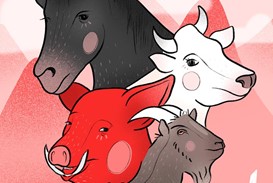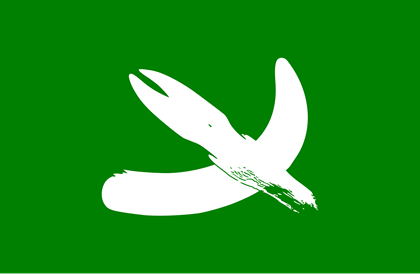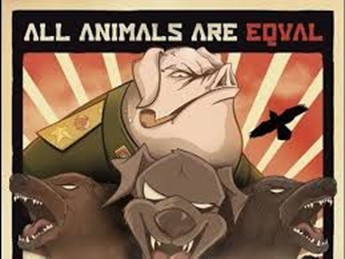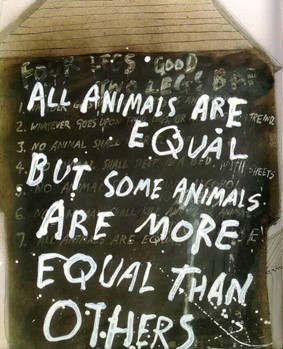Symbolism, metaphors and similes have been an all-time favourite among poets and authors since the inception of writing as an art. Drawing parallels makes it just so simple for the audience to understand what is being conveyed, and wordplay is at its best to enhance the beauty of the writing. They’ve also acted as solid structures of deniability for talking about issues that they could face a backlash against. A lot like when parents tell their children something the children wouldn’t like, as an example or story.
Satires tackle happenings that are sensitive to talk about. “Animal Farm” by George Orwell is an allegorical novel that plays out a significant timeline of the Russian Revolution in the guise of animals on a farm.

Source: bestplayerever
The book was originally “Animal Farm: A Fairy Story”, and was released in England in August 1945. In most parts of the world now, it is known as just Animal Farm. It initially found a place in the kids’ section of the libraries because of its storyline and narrative. But Orwell had a greater plan in mind, he said “Animal Farm was the first book in which I tried, with full consciousness of what I was doing, to fuse political purpose and artistic purpose into one whole.” He had a tough time looking for publishers for the book during the time because of the anti-Russian thoughts it carried.
The premise of the book is very simple and would pass off as a very interesting bedtime story to guileless children. One day, the animals of a farm led by the pigs, decide to take over it by driving the human owner away. They take it into their own hands to run the farm based on an old pig “Major’s” ideals. They decide a framework for the governance of the animals of the farm, figure out the distribution of milk and eggs, divide work, decide on holidays; all of what governance involves. With the support of the other pigs, they set the animals to work for the prosperity of the farm and the happiness of its inhabitants. They make laws, set an education system in place, make huge plans for long term prosperity and eventually, became a whole other class of animals.

Source: Listening Books Blog
Not only the characters of the book, even the provisions, gatherings, chants and every last line of the book draws direct parallels to happenings of the Russian Revolution. The old Major, based on whose ideals their dream of a free farm existed and they eventually went to revolution, was a character for Vladimir Lenin and Karl Marx. Joseph Stalin is represented as Napolean, one of the leaders of the revolution, who eventually had it his way and drove competition (Trotsky) away to rule over the people. Snowball is Leon Trotsky; the magnificent mind, the strategist and the orator who was part of the trio of pigs that led the animals to revolt against Mr. Jones, who plays the guise of Tsar Nicholas II, the usurped. Squealer is the persuasive pig who carries forward Napolean’s plans and characterises Vyacheslav Molotov. The author has left no detail of the farm’s happenings to connect to the revolution. Boxer the horse is like the working class at the time, committed and steadfast but with no mind to see the corruption. The dogs that Napolean eventually employs to guard him at all times are just like what Stalin used the Secret Service for!

Napolean and the other pigs eventually dominate and outclass the other animals of the farm. They become the ruling class aristocrats, while the horses and hens work hard. The other animals are constantly fed the illusion of progress and they remain silent. Those who didn’t remain silent and questioned their actions were executed right away (like the Purge which was ordered by Stalin).
The book drips in communist language and ideologies, and George Orwell has skillfully placed it into the costume of a farm. Eventually, the epitome of Animalism (read “Communism”) is lost and on its pretext, the pigs hog on the fruits of the labour of other animals.
Because the book is a 3rd person perspective of the revolution, some might disagree with the blatant critique by Orwell. While, of course, it gives a biased perspective of a socialist, it does not directly mention any references and can be taken as a purely fictional novel as well.
Trying to explain in this article every element in the book which draws to the 1917-23 happenings in Russia would be a futile effort, because that is exactly what the book does. Apart from being an allegory, the narrative style is very simple to understand, and profound in retrospect. Anyone wanting to not read this book because of the hype around it, should take a step back and treat it as a new release (for it is very relevant in countries even today). Anyone not wanting to read the book for the political talk, should dive right in for the magnificent storytelling by the to-the-point and xsatirical Orwell. For those who haven’t read the book already and want to, should pick it right up xand hunt for more things to enjoy that this article wouldn’t have been able to do justice to!

Source: ThingLink
By Shlok Sampat
References:
Animal Farm: A Fairy Story by George Orwell
Why I Write by George Orwell

Shlok is a sportsperson by day and drama enthusiast by night; he also studies engineering. When he isn’t reading a book or writing down his thoughts, he enjoys referring to himself in the 3rd person. A firm believer in gastronomical pleasures, Shlok often takes detours on his commute routes for the heck of it.
